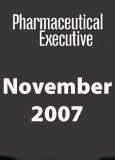Reach KOLs Online
The impact of high-quality online training tools would be difficult and costly to replicate offline given the dynamic and interactive aspects offered
For most pharma companies, key opinion leaders (KOLs) have become an increasingly important part of the team, throughout the entire lifecycle of product development. And at each stage, there are electronic tools to help companies get the most out of their KOLs. Here's an overview:

Alain Eudaric
Phase II: Advice and Consent
Pre–Phase II, KOLs advise on target product profile. Specifically, they assess competitive products (current and future), unmet market needs, considerations for product labeling, and avenues for differentiation. In Phase II, they provide guidance on structuring clinical trial protocols to generate credible, convincing, differentiated data in line with the needs they believe the product might address.
A key online tool for this stage: collaborative software. Community tools let KOLs add comments to documents in an asynchronous fashion, eliminating the need to find common meeting times in physicians' overcrowded schedules and enabling easy sharing of opinions. These tools should be used to manage review requests and document updates in a structured fashion. They can be configured to prohibit the download of a document already checked out or to automatically reinstate a document after a given time if the user has not uploaded an updated version.

Mike Gauthier
Phase III: Going Global
As a drug enters Phase III, brand teams typically engage influential physicians from various relevant markets. That increasingly means international markets. According to Parexel's Bio/Pharmaceutical R&D Statistical Sourcebook 2007/2008, more than 23,000 investigators were working on new FDA-regulated clinical trials. More than 40 percent were located outside the United States, covering 91 countries.
In this stage, password-protected online forums offer an effective way to increase the global reach of Medical Science Liaisons (MSLs) while preserving confidentiality and reinforcing the scientific nature of the online discussions.
Internet KOL portals can be used to provide KOLs with training and reference materials and for general project management of offline KOL activities, such as workshops or symposia. In addition, online forums with MSLs enable the company to collect information from KOLs, such as their perceptions of safety and efficacy data, regional market conditions, and so forth.
Similar solutions already exist for general physician communications. Industry reports claim that the next generation of the "e" relationship will expand beyond e-detailing, toward providing a truly integrated online/offline customer-service experience. Examples of service portals include Pfizerpro.com, Merckservices.com, and Rocheexchange.com.
Given the regulatory attention to separating disease awareness from product messages, brand teams will want advice from their company's regulatory affairs, medical group, and clinical group before sharing data with KOLs. Such discussions should typically begin six months to a year before the end of Phase III.
The therapeutic-area Web site is a place where the brand team can publish concise, transparent, and fair-balance content generated by KOLs, MSLs, or a medical communications agency. Such content normally outlines the therapeutic gaps in the market and starts engaging physician audiences. This is a natural online complement to traditional publications. If the drug gets approved and aligns with one of the highlighted market gaps, adoption and ramp-up in those critical first six months postapproval will only be stronger. A password-protected section on the same site can also provide MSLs easy access to reference information when traveling. It can also provide MSLs with a convenient information warehouse, from which they can e-mail documents (approved by the company's regulatory team) to KOLs and other research physicians they interact with.
The online resource center allows investigators to become more effective advocates. Like the MSL tool just described, it is typically a password-protected repository for registered KOLs with key trial and other evidence-based information. Most often it includes publications, slide decks, webcasts, training materials, and clinical trial materials like the investigator brochure. The center can also include the investigator list, investigator communications, a results summary, claim support, message results, a calendar showing Congress and workshop activities, and news. An "ask the other experts" section can also be used to reinforce communications with MSLs or to enable conversations between KOLs.
Near Approval: Teaching Tools
As a drug reaches the end of Phase III and nears approval, KOLs play a valuable role in informing other physicians about the market gaps and major market evolutions expected. Webcasts, online continuing medical education (CME), and therapeutic-area Web sites are usually the main conduits for such education. For example, one top-15 pharma company uses its therapeutic-area site to discuss the challenges of cardiovascular protection.
The impact of high-quality online training tools would be difficult and costly to replicate offline given the dynamic and interactive aspects offered—animations for mode of action, progressive slide buildings, transitions, and videos. In addition to eliminating the need for travel, the online medium can memorably illustrate physiology and pathology.
Online KOL education can also incorporate an immediate interactive exam following the online session to assess what KOLs have learned. And online tools can be used for future phases. This same survey tool, for instance, can be leveraged with MSLs and later on, during the postapproval phase, with detailing representatives.
On-demand education can be particularly powerful. KOLs get to choose what they want to view and when, which increases the likelihood that they will participate. Programs can employ not just text but the full range of video and audio, all fully hyperlinked to definitions and other content to increase the value of an educational session.
Interactive Web 2.0 features can add dramatically to the value of an interaction. One familiar example is peer content ranking in the form of popularity scores or recommendations (e.g., "physicians who found this content useful also found the articles below useful").
Since a powerful Web-analytics engine tracks activity at the individual KOL level, it can provide insights into variations in feedback, for example, by specialty. And it is possible to assess educational content, such as a videocast by a leading authority, by positioning it with a questionnaire to measure whether the key message was well communicated.
Enabling Advocacy
Advocacy starts several months before the expected launch date with speaker training. Training can be conducted effectively online by providing reference materials and illustrations from some of the KOLs. A user of such online speaker training will see a video from a leading KOL synchronized with the slide kit he/she is reviewing, with key data highlighted on the slide.
As KOLs are identified, biopharmaceutical companies need to develop effective relationships with them. Ideally, a KOL communications program would allow the company to rapidly engage, educate, listen to, and assess KOLs. In reality, MSLs and other professionals managing the KOL relationships lack sufficient time and resources to communicate with their KOLs frequently enough.
Online KOL management tools are increasingly providing solutions to manage these vital relationships. By combining relationship marketing activities with a Web portal, an MSL, a global product manager, or a KOL program manager can engage more KOLs more frequently and with customized content. The portal can be a simple repository of content or a dynamic, personalized resource.
An example of a Web-based tool to increase KOL and physician advocacy around product launch is a trial-alert publication service—a comprehensive Web-based e-mail alert system that highlights the results from clinical trials. This solution leverages Web analytics and Internet communications to:
- Identify suitable target professional audiences, typically prescribing physicians and KOLs in a specific area
- Engage those audiences regularly
- Create a database of professionals for future communications
- Control clinical statements from a regulatory perspective.
The advantage of this type of tool is that it typically leverages existing editorial materials and extends their reach to a much wider audience for a relatively low incremental cost.
Integrated Messaging
The Web is most effective when it is integrated with all other KOL communications. KOL experiences with the brand team should be complementary, regardless of whether KOLs were first engaged offline or online.
There are three keys to building a successful relationship:
Duration Multiple contacts over an extended time
Diversity Frequent contacts and different activities
Depth Quality activities that build over time.
These fundamentals ensure that a brand's unique medical profile is clearly communicated and that strong relationships for change and progress in patient care are fostered.
Alain Eudaric is director of corporate strategy at Parexel Medical Communications. He can be reached at alain.eudaric@parexel.com
Mike Gauthier is founder and CEO of eTractions. He can be reached at mgauthier@e-tractions.com

The Misinformation Maze: Navigating Public Health in the Digital Age
March 11th 2025Jennifer Butler, chief commercial officer of Pleio, discusses misinformation's threat to public health, where patients are turning for trustworthy health information, the industry's pivot to peer-to-patient strategies to educate patients, and more.
Navigating Distrust: Pharma in the Age of Social Media
February 18th 2025Ian Baer, Founder and CEO of Sooth, discusses how the growing distrust in social media will impact industry marketing strategies and the relationships between pharmaceutical companies and the patients they aim to serve. He also explains dark social, how to combat misinformation, closing the trust gap, and more.